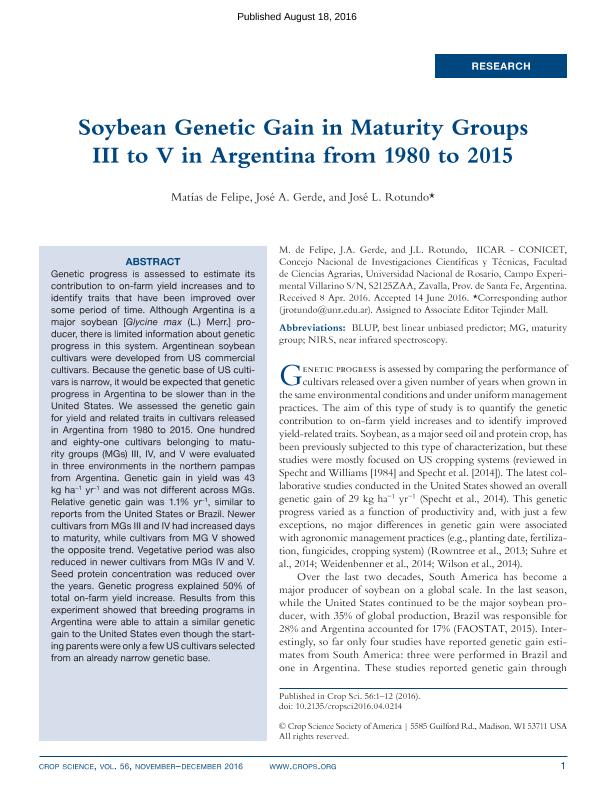Mostrar el registro sencillo del ítem
dc.contributor.author
de Felipe, Matías

dc.contributor.author
Gerde, Jose Arnaldo

dc.contributor.author
Rotundo, José Luis

dc.date.available
2018-07-20T15:06:20Z
dc.date.issued
2016-11
dc.identifier.citation
de Felipe, Matías; Gerde, Jose Arnaldo; Rotundo, José Luis; Soybean genetic gain in maturity groups III to V in Argentina from 1980 to 2015; Crop Science Society of America; Crop Science; 56; 6; 11-2016; 3066-3077
dc.identifier.issn
0011-183X
dc.identifier.uri
http://hdl.handle.net/11336/52719
dc.description.abstract
Genetic progress is assessed to estimate its contribution to on-farm yield increases and to identify traits that have been improved over some period of time. Although Argentina is a major soybean [Glycine max (L.) Merr.] producer, there is limited information about genetic progress in this system. Argentinean soybean cultivars were developed from US commercial cultivars. Because the genetic base of US cultivars is narrow, it would be expected that genetic progress in Argentina to be slower than in the United States. We assessed the genetic gain for yield and related traits in cultivars released in Argentina from 1980 to 2015. One hundred and eighty-one cultivars belonging to maturity groups (MGs) III, IV, and V were evaluated in three environments in the northern pampas from Argentina. Genetic gain in yield was 43 kg ha−1 yr−1 and was not different across MGs. Relative genetic gain was 1.1% yr−1, similar to reports from the United States or Brazil. Newer cultivars from MGs III and IV had increased days to maturity, while cultivars from MG V showed the opposite trend. Vegetative period was also reduced in newer cultivars from MGs IV and V. Seed protein concentration was reduced over the years. Genetic progress explained 50% of total on-farm yield increase. Results from this experiment showed that breeding programs in Argentina were able to attain a similar genetic gain to the United States even though the starting parents were only a few US cultivars selected from an already narrow genetic base.
dc.format
application/pdf
dc.language.iso
eng
dc.publisher
Crop Science Society of America

dc.rights
info:eu-repo/semantics/openAccess
dc.rights.uri
https://creativecommons.org/licenses/by-nc-sa/2.5/ar/
dc.subject
Soybean
dc.subject
Breeding
dc.subject
Genetic Gain
dc.subject
Seed Composition
dc.subject.classification
Agricultura

dc.subject.classification
Agricultura, Silvicultura y Pesca

dc.subject.classification
CIENCIAS AGRÍCOLAS

dc.title
Soybean genetic gain in maturity groups III to V in Argentina from 1980 to 2015
dc.type
info:eu-repo/semantics/article
dc.type
info:ar-repo/semantics/artículo
dc.type
info:eu-repo/semantics/publishedVersion
dc.date.updated
2018-07-18T20:45:01Z
dc.journal.volume
56
dc.journal.number
6
dc.journal.pagination
3066-3077
dc.journal.pais
Estados Unidos

dc.journal.ciudad
Baltimore
dc.description.fil
Fil: de Felipe, Matías. Consejo Nacional de Investigaciones Científicas y Técnicas. Centro Científico Tecnológico Conicet - Rosario. Instituto de Investigaciones en Ciencias Agrarias de Rosario. Universidad Nacional de Rosario. Facultad de Ciencias Agrarias. Instituto de Investigaciones en Ciencias Agrarias de Rosario; Argentina
dc.description.fil
Fil: Gerde, Jose Arnaldo. Consejo Nacional de Investigaciones Científicas y Técnicas. Centro Científico Tecnológico Conicet - Rosario. Instituto de Investigaciones en Ciencias Agrarias de Rosario. Universidad Nacional de Rosario. Facultad de Ciencias Agrarias. Instituto de Investigaciones en Ciencias Agrarias de Rosario; Argentina
dc.description.fil
Fil: Rotundo, José Luis. Consejo Nacional de Investigaciones Científicas y Técnicas. Centro Científico Tecnológico Conicet - Rosario. Instituto de Investigaciones en Ciencias Agrarias de Rosario. Universidad Nacional de Rosario. Facultad de Ciencias Agrarias. Instituto de Investigaciones en Ciencias Agrarias de Rosario; Argentina
dc.journal.title
Crop Science

dc.relation.alternativeid
info:eu-repo/semantics/altIdentifier/doi/http://dx.doi.org/10.2135/cropsci2016.04.0214
dc.relation.alternativeid
info:eu-repo/semantics/altIdentifier/url/https://dl.sciencesocieties.org/publications/cs/abstracts/56/6/3066
Archivos asociados
